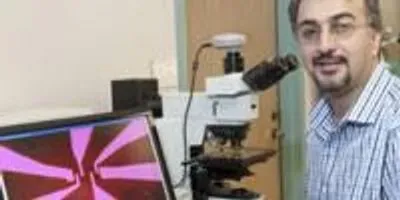 Amin Salehi-Khojin, assistant professor of mechanical engineering.Roberta Dupuis-Devlin/UIC Photo ServicesThe study is available online in advance of print in Nature Communications.
Amin Salehi-Khojin, assistant professor of mechanical engineering.Roberta Dupuis-Devlin/UIC Photo ServicesThe study is available online in advance of print in Nature Communications.
In many applications, grain boundaries are considered faults because they scatter electrons and may weaken the lattice. But Amin Salehi-Khojin, UIC assistant professor of mechanical and industrial engineering, and his colleagues showed that these imperfections are important to the working of graphene-based gas sensors. The team created a micron-sized, individual graphene grain boundary in order to probe its electronic properties and study its role in gas sensing.
Their first discovery was that gas molecules are attracted to the grain boundary and accumulate there, rather than on the graphene crystal, making it the ideal spot for sensing gas molecules. A grain boundary’s electrical properties attract molecules to its surface.
A theoretical chemistry group at UIC, led by Petr Kral, was able to explain this attraction and additional electronic properties of the grain boundary. The irregular nature of the grain boundary produces hundreds of electron-transport gaps with different sensitivities.
“It’s as though we have multiple switches in parallel,” said graduate student Poya Yasaei, first author on the paper. “Gas molecules accumulate on the grain boundary; there is a charge transfer; and, because these channels are all paralleled together, all the channels abruptly open or close. We see a very sharp response.”
Researchers have been trying to develop a highly sensitive and robust sensor for decades, said UIC postdoctoral fellow Bijandra Kumar, a co-author on the paper.
“We can synthesize these grain boundaries on a micrometer scale in a controlled way,” Kumar said. “We can easily fabricate chip-scale sensor arrays using these grain boundaries for real-world use.”
Salehi-Khojin said it should be possible to “tune” the electronic properties of graphene grain-boundary arrays using controlled doping to obtain a fingerprint response — thus creating a reliable and stable “electronic nose.”
With the grain boundary’s strong attraction for gas molecules and the extraordinarily sharp response to any charge transfer, such an electronic nose might be able to detect even a single gas molecule, Salehi-Khojin believes, and would make an ideal sensor.
Other co-authors are Reza Hantehzadeh, Artem Baskin, Nikita Repnin, Canhui Wang and Robert Klie of UIC and Morteza Kayyalha and Yong Chen of Purdue University.
This work was supported by a UIC Startup budget; National Science Foundation DMR Grant No. 1309765; the acquisition of the UIC JEOL JEM-ARM200CF is supported by a MRI-R2 NSF grant, DMR-0959470; resources of the National Energy Research Scientific Computing Center, supported by the Office of Science of the U.S. Department of Energy under Contract No. DE-AC02-05CH11231, and the Extreme Science and Engineering Discovery Environment (XSEDE), supported by the NSF Grant No. OCI-1053575; and partial support from the U.S. Defense Threat Reduction Agency.



 Amin Salehi-Khojin, assistant professor of mechanical engineering.
Amin Salehi-Khojin, assistant professor of mechanical engineering.






